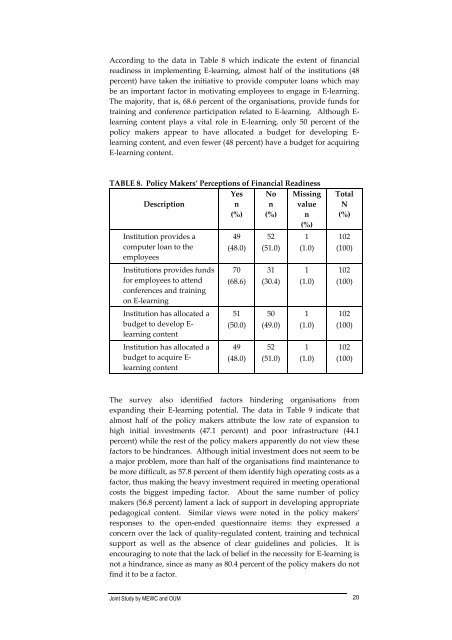e-learning readiness - Asia Pacific Region - Open University Malaysia
e-learning readiness - Asia Pacific Region - Open University Malaysia
e-learning readiness - Asia Pacific Region - Open University Malaysia
- No tags were found...
You also want an ePaper? Increase the reach of your titles
YUMPU automatically turns print PDFs into web optimized ePapers that Google loves.
According to the data in Table 8 which indicate the extent of financial<strong>readiness</strong> in implementing E-<strong>learning</strong>, almost half of the institutions (48percent) have taken the initiative to provide computer loans which maybe an important factor in motivating employees to engage in E-<strong>learning</strong>.The majority, that is, 68.6 percent of the organisations, provide funds fortraining and conference participation related to E-<strong>learning</strong>. Although E-<strong>learning</strong> content plays a vital role in E-<strong>learning</strong>, only 50 percent of thepolicy makers appear to have allocated a budget for developing E-<strong>learning</strong> content, and even fewer (48 percent) have a budget for acquiringE-<strong>learning</strong> content.TABLE 8. Policy Makers’ Perceptions of Financial ReadinessDescriptionYesn(%)Non(%)Missingvaluen(%)Institution provides a 49 52 1computer loan to the (48.0) (51.0) (1.0)employeesInstitutions provides fundsfor employees to attendconferences and trainingon E-<strong>learning</strong>Institution has allocated abudget to develop E-<strong>learning</strong> contentInstitution has allocated abudget to acquire E-<strong>learning</strong> content70(68.6)51(50.0)49(48.0)31(30.4)50(49.0)52(51.0)1(1.0)1(1.0)1(1.0)TotalN(%)102(100)102(100)102(100)102(100)The survey also identified factors hindering organisations fromexpanding their E-<strong>learning</strong> potential. The data in Table 9 indicate thatalmost half of the policy makers attribute the low rate of expansion tohigh initial investments (47.1 percent) and poor infrastructure (44.1percent) while the rest of the policy makers apparently do not view thesefactors to be hindrances. Although initial investment does not seem to bea major problem, more than half of the organisations find maintenance tobe more difficult, as 57.8 percent of them identify high operating costs as afactor, thus making the heavy investment required in meeting operationalcosts the biggest impeding factor. About the same number of policymakers (56.8 percent) lament a lack of support in developing appropriatepedagogical content. Similar views were noted in the policy makers’responses to the open-ended questionnaire items: they expressed aconcern over the lack of quality-regulated content, training and technicalsupport as well as the absence of clear guidelines and policies. It isencouraging to note that the lack of belief in the necessity for E-<strong>learning</strong> isnot a hindrance, since as many as 80.4 percent of the policy makers do notfind it to be a factor.Joint Study by MEWC and OUM 20
















